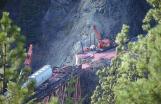28
The role of the railways has changed over the last 120 years. They initially brought thousands of workers into the area. After initial construction, they based work and train crews in Lytton and provided local and long distance transportation for both passengers and freight.All of these jobs provided a stable economic base for Lytton. Restaurants and stores were supplying dozens of families with railway incomes.
Now, with electronics and diesel power, even the track monitoring is done from hundreds of miles away. A few local workers keep the entire system maintained. Larger projects bring in work crews from afar. The trains no longer stop here, except to wait for other trains to pass.
While the Village of Lytton once collected taxes on the railroad track and buildings within the Village boundaries, the Provincial government now taxes the industrial equipment and gives the Village a grant -in-lieu of taxes. This has changed the tax base for the Village.
Both railways dispose of all structures as soon they become expendable. Stations, water towers, service buildings have all been destroyed to eliminate the payment of taxes.
These structures were often historic landmarks for the railroads. They could have become a vital part of our attempt to keep railroad heritage alive for our residents and visitors.
